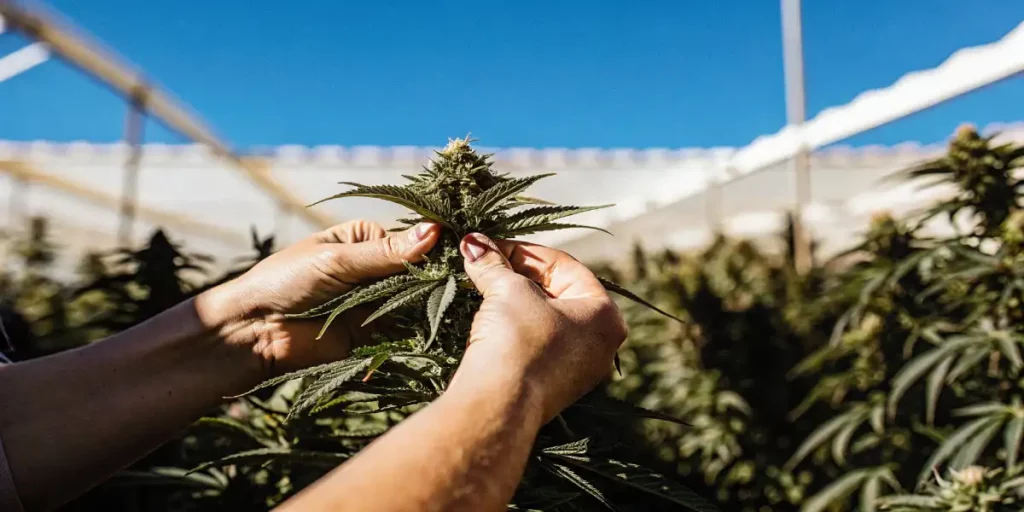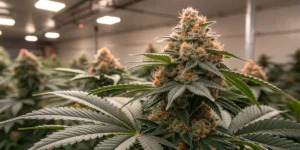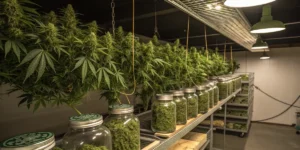Defoliating autoflowers is a delicate process that can significantly enhance your cannabis growing experience. Whether you’re a newbie or a seasoned grower, knowing the best techniques for defoliating autoflower cannabis can make a huge difference. It’s all about finding the right balance to ensure your plants thrive.
Autoflower strains, like the popular Gorilla Glue 4 from Global Green Genetics, don’t rely on light cycles to start flowering. This unique trait makes them easier for beginners but defoliating these plants requires a bit of finesse. You want to remove only the leaves that are necessary to ensure light penetrates the canopy without stressing the plant.
Defoliation involves removing excess leaves to improve light exposure and airflow. For autoflowers, which are generally smaller and faster growing, the timing and method of defoliation are crucial. Removing too many leaves too quickly can stunt growth and reduce yield. Let’s explore how to defoliate autoflower cannabis plants effectively.
When to Defoliate Autoflower Marijuana Plants
Timing is crucial in defoliating autoflowers. These plants transition from seedling to flowering much faster than photoperiod strains. The right moment to start defoliating is usually during the vegetative stage. Keep an eye on your plants, and once they are healthy and robust, you can begin the process.
It’s essential to defoliate in moderation. Unlike traditional photoperiod strains, autoflowers have limited time to recover from any stress. A few well-placed snips can improve light penetration and air circulation without hampering growth. For instance, strains like Auto Blueberry from buycannabisseeds.net benefit from strategic defoliation to enhance their vibrant buds.
Knowing when to defoliate autoflower marijuana plants is key to maximizing their potential. As autoflowers grow rapidly, starting too late can mean missed opportunities for boosting light exposure and airflow. By focusing on the vegetative stage, growers can leverage the plant’s natural growth cycle, ensuring a healthier and more productive outcome.
Careful observation of plant health and growth patterns will guide the timing of defoliation. Look for signs of robust growth, such as thick stems and plentiful leaves, before beginning. This readiness indicates that the plant can handle the stress of leaf removal, making defoliating autoflowers a strategic move rather than a gamble.
Best Techniques for Defoliating Autoflower Cannabis
Start by selecting the right tools. Sharp, clean scissors are a must to avoid damaging the plant. Begin by removing any large fan leaves that block light from reaching lower bud sites. This opens up the canopy and promotes better airflow. It’s a straightforward but effective technique.
Another method is to remove yellowing leaves. These leaves no longer contribute to the plant’s energy production. By removing them, you help the plant focus on healthier growth. Don’t forget to sanitize your tools between plants to prevent the spread of disease.
Besides to basic techniques, growers might employ selective pruning to shape the plant’s growth. This involves strategically removing certain leaves to guide the plant’s energy towards more productive areas, ultimately impacting the defoliation on autoflower yield positively. This nuanced approach can be especially beneficial for dense strains.
Another advanced technique is the gradual defoliation process. Instead of removing leaves in one session, spread the process over several days. This reduces shock to the plant and allows it to adjust to changes more smoothly, optimizing the benefits of defoliation while minimizing risks.
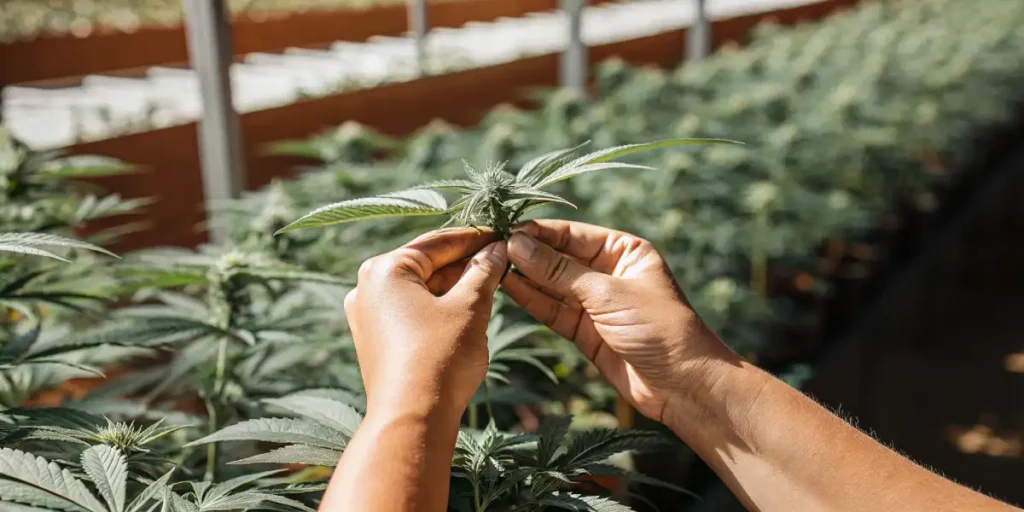
Pros and Cons of Defoliating Autoflower Plants
Defoliating autoflowers offers several benefits. Improved light penetration ensures all parts of the plant receive adequate sunlight, promoting even growth. This can lead to increased bud size and density. Better airflow also reduces the risk of mold and pests.
However, there are downsides. Over-defoliation can stress the plant, leading to stunted growth or lower yields. Autoflowers have a fixed life cycle, so any setbacks can be costly. It’s crucial to understand your plant’s needs and respond accordingly. This way, you can maximize the impact of defoliation on autoflower yield.
The pros and cons of defoliating autoflower plants should be carefully weighed before proceeding. While the potential for increased yield and reduced pest issues is enticing, the risk of irreversible stress is a serious consideration. Each grower must assess their unique situation to determine if the benefits outweigh the risks.
Experimentation with small batches can help growers understand the specific pros and cons for their strains. By keeping detailed records of plant responses and outcomes, growers can develop a tailored approach that maximizes benefits while minimizing risks, refining their techniques over time.
Real-life Examples of Defoliating Autoflowers
Consider a grower working with a dense canopy of Gorilla Glue 4. They might start by removing a few large fan leaves that shade lower branches. This simple act can make a noticeable difference, allowing lower buds to develop better.
For another grower with Blueberry Auto, defoliation might involve removing some lower leaves that receive little light. This encourages the plant to focus its energy on the main colas, resulting in a more potent harvest.
In a different scenario, a grower focusing on Northern Lights Auto might notice that selective leaf removal enhances bud exposure to light, leading to a denser canopy. These real-life examples of defoliating autoflowers highlight the importance of knowing specific plant needs to optimize growth.
By documenting and sharing their experiences, growers can contribute to a collective knowledge base, helping others refine their techniques. Observing how plants respond to different defoliation methods can lead to innovative strategies that push the boundaries of traditional growing practices.
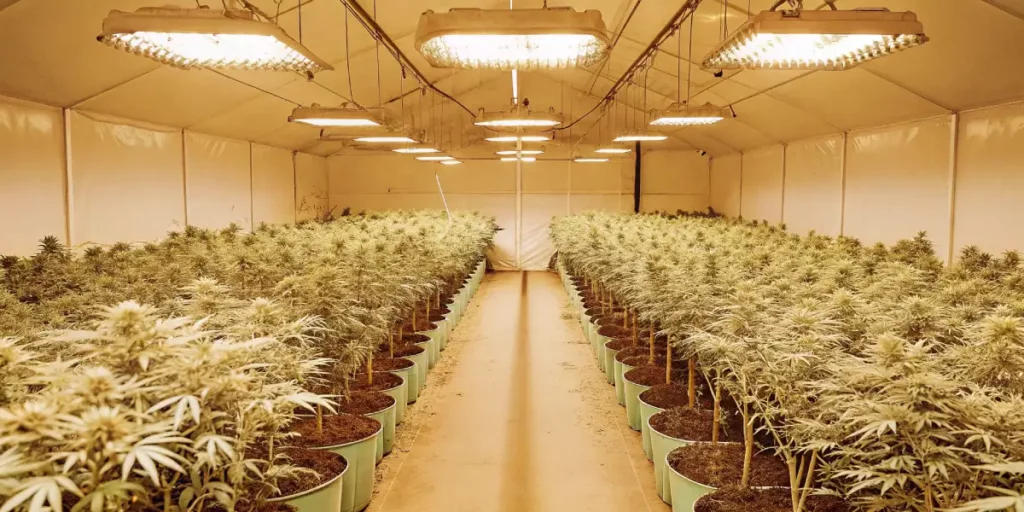
FAQ About Defoliating Autoflowers
What is the best time to start defoliating autoflowers?
The best time to start defoliating autoflowers is during the vegetative stage. This is when the plant is robust enough to handle the stress of leaf removal. As autoflowers transition quickly to flowering, early defoliation can be more forgiving.
Monitor your plant’s growth and start defoliating once it has a full set of leaves. This usually happens a few weeks after germination. By acting early, you allow your autoflowers to recover and focus energy on developing strong buds.
Starting defoliation at the right time is a critical decision. Early intervention can make a significant difference in plant development, as it allows for better light distribution and energy allocation. The goal is to strengthen the plant before it enters its rapid flowering phase.
Growers should be patient and observe the plant’s growth patterns. A slow and steady approach ensures that defoliation supports rather than hinders development, making the timing of defoliating autoflowers a key factor in overall success.
Can defoliation increase the yield of autoflowers?
Yes, defoliation can increase the yield of autoflowers when done correctly. By improving light exposure and airflow, you help the plant grow more efficiently. This can lead to larger and denser buds, enhancing overall yield.
However, it’s vital to be cautious. Removing too many leaves can have the opposite effect, stunting growth and reducing yield. Always aim for a balanced approach to achieve the best results.
The potential impact of defoliation on autoflower yield is significant but requires careful execution. By focusing on strategic leaf removal, growers can enhance bud development without over-stressing the plant. This fine balance is crucial for achieving the desired outcome.
Growers seeking to boost yields should experiment with different defoliation strategies. Keeping detailed records of plant responses can help refine techniques, optimizing the benefits of this practice while minimizing its risks.
What are the risks of defoliating autoflower cannabis plants?
One risk when defoliating autoflowers is over-defoliation, which can stress the plant. Autoflowers have a limited life cycle, so any stress can significantly impact growth and yield. It’s crucial to remove leaves gradually and observe how the plant reacts.
Another risk is the potential for infection if tools are not sanitized. Always use clean, sharp scissors to prevent introducing pathogens to the plant. This simple step can save you from significant issues down the line.
Knowing the potential risks of defoliating autoflower cannabis plants is essential for any grower. Besides to stress, improper techniques can lead to long-term health issues. Careful planning and execution are vital to avoid negative outcomes.
By staying vigilant and responsive to plant needs, growers can minimize risks. Regular monitoring and adaptation allow for a more resilient plant, ensuring that defoliation complements rather than compromises overall plant health.
How do I know if I’ve defoliated too much?
If your plant shows signs of stress, such as wilting or discoloration, you may have defoliated too much. Autoflowers should still appear vibrant and healthy after defoliation. Monitor your plants closely after each session.
Another sign of over-defoliation is slow growth. If your plant’s development stalls, it might be a result of too much leaf removal. Adjust your approach by defoliating less and allowing the plant time to recover.
Recognizing the signs of excessive defoliation is crucial for maintaining plant health. Symptoms like leaf curling, color changes, and reduced vigor indicate distress. Acting quickly to adjust techniques can help mitigate further issues.
Regular assessment and a cautious approach prevent over-defoliation. By knowing plant responses, growers can fine-tune their methods, ensuring that defoliation supports rather than hinders growth and yield.
Are there specific strains that respond well to defoliation?
Some strains like Gorilla Glue, Auto Blueberry, and Auto Northern Lights from Global Green Genetics respond well to defoliation. These strains can benefit from improved light exposure and airflow, leading to better yields.
Different strains have unique growth patterns, so it’s important to tailor your defoliation technique to each plant. By knowing your strain’s characteristics, you can maximize the potential benefits of defoliation.
Identifying specific strains that thrive with defoliation can be a game-changer for growers. Not all strains will respond equally, so knowing the particular needs and characteristics of each variety is essential for success.
Experimentation and observation are key to identifying responsive strains. By tailoring techniques to individual plant characteristics, growers can unlock the full potential of defoliating autoflowers, leading to improved yield and plant health.

